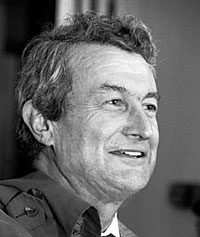|
Paul Spencer Byard, FAIA, a partner in the firm of Platt Byard Dovell White Architects in New York City, and the director of the historic preservation program at Columbia University, died on July 15 of colon cancer. He was 68 years old.
Born in 1939 in New York City, Byard long advocated a modern approach to preservation and restoration, as his book, The Architecture of Additions, Design and Regulation (1998), convincingly reveals. In the book Byard argues that innovative expressive design can enhance the older, original, and often historic structure to which it is appended by adhering to certain principles. For one, the responsible addition is one that “treats the old body respectfully, like a collaboration” he writes, “and works out its insights of real value.”
Byard attempted to bring this sense of collaboration into his architecture. He was heavily involved in Platt Byard Dovell White’s design for the additions to the Green-Wood Cemetery (2006), the new 42nd Street Studio (2000), and the Chanel 57 building renovation (1997). One particular project in which Byard played a significant role was Cedar Lake Ensemble in New York, where the firm converted two garages into performance spaces (2006). Similarly, Byard’s dual interest in modern design and historic preservation influenced his contributions to the preservation program at Columbia’s Graduate School of Architecture, Planning and Preservation (GSAPP). There he initiated a joint design and preservation studio for third-year graduate students so that both disciplines could learn how to fruitfully explore together additions to significant buildings.
The theme of reconciling a split, seen in Byard’s modernist/preservationist approach to architecture, interestingly can be detected in the manner in which Byard came to this field. Byard graduated with a BA from Yale in 1961, and then got another BA in 1963 (with an MA conferred later) after studying at Clare College Cambridge. He then decided to enter Harvard Law School, from which he obtained an LLB in 1966.
After working a number of years in the 1970s as a lawyer, including acting as general counsel to the Roosevelt Island Development Corporation, and associate counsel to the New York State Urban Development Corporation, Byard returned to school: this time he matriculated in Columbia’s GSAPP, where he earned his M.Arch in 1977. Soon after, Byard joined the firm of James Polshek, then dean of the GSAPP, and worked on the renovations of Carnegie Hall and the Villard Houses.
During Byard’s architectural career, he served on several organizations involved in planning, architecture, and preservation. His tenure as president of the New York Architectural League from 1989 to 1994 was distinctive: under his aegis, the League organized the landmark 1992 exhibition Renzo Piano Building Workshop: Selected Projects, curated by Peter Buchanan. Byard also was heavily involved in a number of socially oriented projects the League took on during those years, including Vacant Lots (1987), a design study proposing infill housing on unused property in New York.
Byard also was on the board of the New York Landmarks Conservancy, where he was instrumental in establishing the Historic Properties Fund for the various New York City boroughs. Since 1982, the revolving loan fund has enabled more than 200 properties to receive $18 million in loans for preservation purposes.
In the architectural community, Byard was particularly memorable for his courtly yet ebullient air. With a white handkerchief (always) spilling jauntily out of his (typically tweed) jacket pocket, he would introduce the most avant-garde architect to a League presentation with a trenchant, informed, and witty commentary.
A memorial service is planned for Byard at 4 p.m., September 15, at St. Paul’s Chapel, Columbia University.





Post a comment to this article
Report Abusive Comment